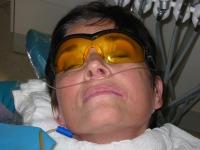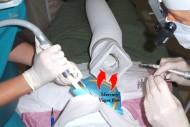Superior Index
Print Files: A4 Size (pdf), Text (txt).
Protocol for Mercury/Silver Filling Removal
International Academy of Oral Medicine and Toxicology
IAOMT [1]
Download from www.holisticmed.com in september of 2011.
Contents
1 Patient protection
2 Staff protection
1 Patient protection
First in every concerned doctor's mind is the protection of the patient from additional exposure to mercury. This is especially true of the mercury toxic patient. The mercury toxic patient may have been exposed to varying amounts of mercury from diet, environment, employment or from mercury/silver dental fillings. All forms are cumulative and can contribute to the body burden. The goal of this preferred procedure is to minimize any additional exposure of the patient, ourselves, or staff to mercury.
During chewing the patient is exposed to intraoral levels which are several times the EPA allowable air concentration [2]. During the removal or placement of amalgam the patient can be exposed to amounts which are a thousand times greater than the EPA allowable concentration [3]. Once the drill touches the filling temperature increases immediately vaporizing the mercury component of the alloy. There are 8 steps to greatly reducing everyone's exposure.
- Keep the fillings cool. All removal must be done under cold water spray with copious amounts of water. Once the removal has begun, the mercury vapor will be continuously released from the tooth.
- Therefore, a high volume evacuator tip should be kept near the tooth (1/2 inch) at all times to evacuate this vapor from the area of the patient. Polishing amalgam can create very dangerous levels of mercury and should be avoided especially for the mercury toxic patient.
- All patients having amalgam removed or placed should be provided with an alternative air source and instructed to not breathe through their mouth during treatment. A nasal hood such as is used with the nitrous oxide analgesia equipment is excellent. Air is best and oxygen is acceptable although not required. If just air is used it should be clean and free of mercury vapor preferably from outside the dental office.
- Particles of mercury alloy should be washed and vacuumed away as soon as they are generated. The filling should be sectioned and removed in large pieces to reduce exposure.
At present the International Academy of Oral Medicine and Toxicology (IAOMT) has approved removal both with and without the use of a rubber dam. Some evidence exist to support both views since high levels of mercury and amalgam particles can be found under the dam. All members are agreed that whether or not a rubber dam is used the patient should be instructed to not breathe through their mouth or swallow the particles. Some experts feel that it is better to remove the amalgam first and then apply the dam if needed for restorative procedures.
- After the fillings have been removed, take off the rubber dam if one was used and lavage the patients mouth for at least 30 seconds with cold water and vacuum. Remove your gloves and replace them with a new pair. If a restorative procedure is next then reapply a new dam and proceed.
- Immediately change patients protective wear and clean their face.
- Consider appropriate nutritional support before, during and after removal.
- Install room air purifiers or ionizers and fans for everyone's well being.
 Figure 1: Dental mask and safety glasses protecting nostrils and eyes.
Figure 1: Dental mask and safety glasses protecting nostrils and eyes.
 Figure 2: A high-volume air evacuator.
Figure 2: A high-volume air evacuator.
2 Staff protection
OSHA [4],[5] requires that employees be given written informed consent before the use of any toxic chemicals of which mercury is one. Elemental mercury vapor is one of the most toxic forms of mercury and should not breathed. Women of child bearing age should be exposed to no more than 10% of the OSHA MAC [6]. Women who are pregnant should be exposed to no mercury [7]. If you use mercury or remove mercury in any form the National Institute of Occupational Safety and Health (NIOSH) has recommended that your employees be medically monitored annually.
- Any mercury exposure requires that the employee wear an approved mercury filter mask. An approved mask is appropriate for wearing during all dental procedures which will expose you or your staff to mercury [8].
The manner in which dentists operate their equipment dramatically affects the amount of mercury released. Never drill on mercury high dry. It is hazardous to you, your staff, and your patient. Levels as high as 4000 mg/m3 have been measured 18 inches from the drill when used high dry. Levels over 1000 mg/m3 are measurable upon opening an amalgam mixing capsule.
One out of 7 California dental offices tested over the OSHA TWA of 50 mg/m3. 100% of the vacuum cleaner exhaust tested over 100 mg/m3. Any office where mercury is used should be tested regularly and staff should be monitored for exposure. Testing services are available and a mercury sensor badge is available for personnel monitoring. They should test inside storage areas and along baseboards where mercury might have dropped. Office spills can go undetected for years and are extremely hazardous. The International Academy of Oral Medicine and Toxicology protocol committee seeking submissions to the Standards of Care Protocol/Preferred Procedures. We are particularly concerned and interested in detoxification. A one page self explanatory form is in the meeting packet.
References
- [1]
- IAOMT Standards of Care Preferred Procedure Approved 9/27/92
- [2]
- EPA United States Environmental Protection Agency Office of Health and Environment Assessment Mercury health effects update Final Report EPA-600/8-84-019F 1971 EPA
- [3]
- Cooley RL, Barkmeier WW: Mercury vapor emitted during ultraspeed cutting of amalgam. J Indiana Dent Assoc 57:28-31, 1978
- [4]
- OSHA Job Health Series: Mercury.(2234)8/1975
- [5]
- Hazard Communication Program Federal Register/ Vol. 52. No. 163 / Monday, August 24, 1987
- [6]
- OSHA MAC is Threshold Limit Value of 100 micrograms/ cubic meter or 100 PPM This is a never to be exceeded standard.
- [7]
- Koos BJ and Lango LD , Mercury Toxicity in the pregnant woman, fetus, and newborn infant. A review Am J Obstetrics and Gynecology 126(3):390-409, 1976
- [8]
- Mine Safety Association high levels and 3M mercury dust mask lower levels


